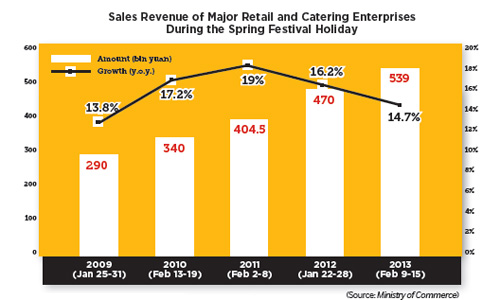|
 |
|
BUYING MOOD: Consumers shop at a gold jewelry store in Ningbo, Zhejiang Province, on January 12 (SUO XIANGLU) |
With continuously improving living standards, electronic products and household electric appliances have become the new favorite presents given to relatives and friends. Sales of handsets, computers and cameras all show blowout growth.
Electronic products, such as SLR cameras and tablet computers, topped the list of most favored Spring Festival gifts, with sales revenue of high-end digital products jumping 36 percent year on year.
During the holiday, home appliance chain stores in Beijing, like Dazhong, Gome and Suning, saw cumulative sales revenue of 250 million yuan ($40 million).
Travel rush
In the past, people tended to stay at home for a family reunion. However, with China's remarkable social and economic progress, a stronger sense of recreation is beginning to surface. Furthermore, the exemption of highway tolls also help drive the expansion of the domestic tourism market.
During the holiday, 39 major tourism cities registered a total of 76 million visits, a 15-percent year-on-year increase, showed MOFCOM statistics.
Major tourist attractions remained crowded with tourists. Wuzhen in east China's Zhejiang Province took the lead among first-tier scenic areas, receiving 203,200 tourists, up 39.81 percent year on year. The number of tourists heading for Sanya in south China's Hainan Province soared by 12 percent to 247,000. Duty-free shops in Sanya were overwhelmingly popular. From February 10 to 15, sales revenue exceeded 130 million yuan ($20.84 million).
According to the 2013 Statistical Report on Tourism released by the National Holiday Tourism Office, a total of 203 million tourism trips were registered during the Spring Festival holiday, up 15.1 percent year on year, with total tourism revenue hitting 117.1 billion yuan ($18.78 billion). Per-capita consumption stood at 576.65 yuan ($92.4), up 0.09 percent year on year.
Statistics from the National Tourism Administration (NTA) showed that during the 2013 Spring Festival, travel agencies registered 4 million outbound travel trips, up 14 percent year on year, and 90 percent of those trips were to Asian destinations. Countries and regions such as Thailand, South Korea, Hong Kong, Macao and Taiwan were some of the more popular destinations for outbound travelers.
To brace for the shopping spree, overseas stores not only employed staff who can speak Chinese, but made other accommodations. In duty-free stores, labels were printed in simplified Chinese, and Chinese tourists were able to pay using their local debit cards and in renminbi, the Chinese currency.
"When I first arrived in Nepal, I found Chinese tourists everywhere, and many local people can speak a little Chinese," said Zhang Jing, a 34 year-old Beijing resident, who signed up for a package tour to Nepal during the holiday and spent eight days in the capital Kathmandu, the world heritage site Chitwan National Park and the famous scenery site Pokhara. She paid 15,000 yuan ($2,405) for her package tour and spent 2,000 yuan ($321) more on shopping.
As the number of outbound travelers from Europe and the United States continues to decline, travelers from China made 80 million outbound trips in 2012, said the NTA. According to a report by The Washington Post, overseas consumption by Chinese people reached $85 billion in 2012, two times the annual revenue of Exxon Mobil, the U.S. oil giant with the highest revenue.
In some sense, it's safe to say China's Spring Festival now has a global reach.
Email us at: dengyaqing@bjreview.com
 |
